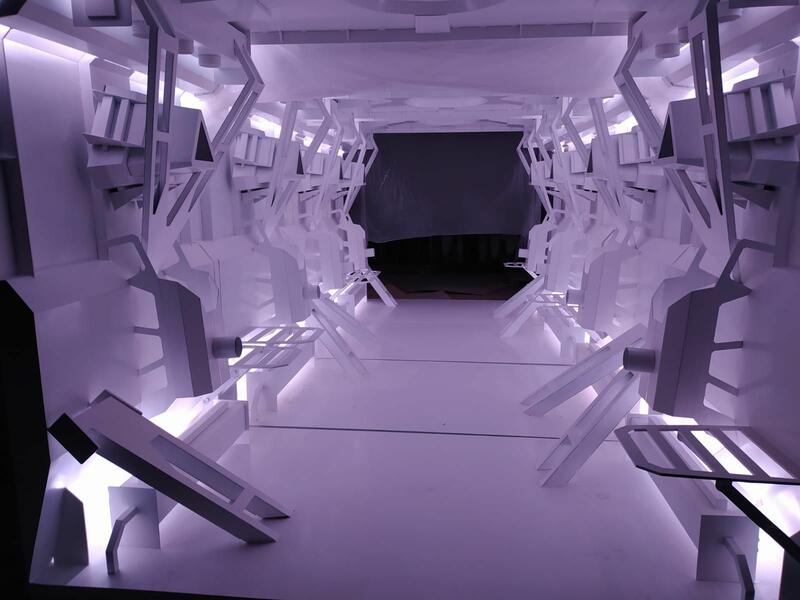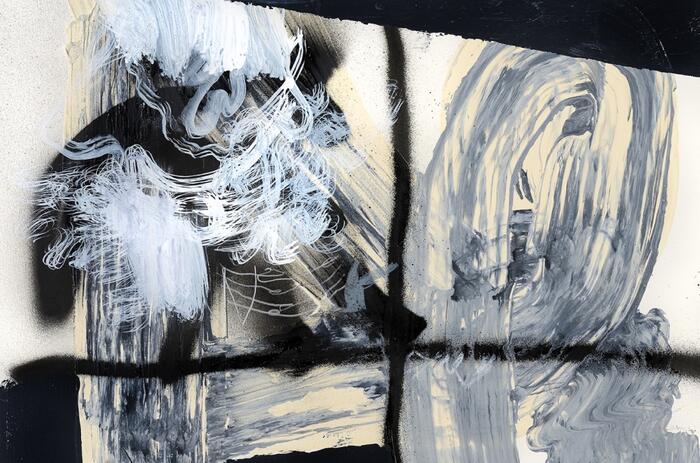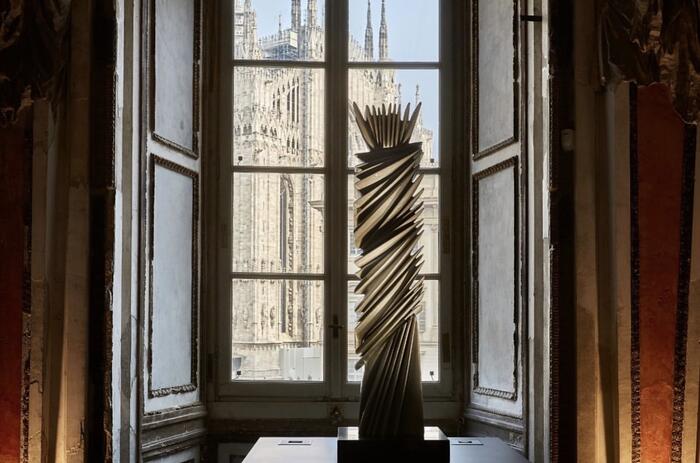DAGOBERTO RODRÍGUEZ: OMENS OF THE FUTURE
Dagoberto Rodríguez (1969, Caibarién, Cuba) presents Planeta de Cristal (Crystal Planet), his first solo exhibition in Miami, recently opened to the public. It collects part of his production from 2020 and confirms the vitality that his already long and successful career preserves, which, with notable international recognition, has spanned the past three decades. The artist was first part, until very recently, of the Los Carpinteros collective, and then, since 2017, he works and exhibits on his own.

The exhibition is composed of a large group of works of different sizes and media that make up the series that gives it its title. This includes large-format watercolors such as Crystal Planet II, Blue Light, Ice 7, Gray Bunker, Clay Bunker, and others of medium size dimensions such as The End, Diamond Building, Floating Balconies, Clay Planet, Brick Iceberg and Collision. They are accompanied by a video, Popular Geometry, and a group of stills from it. Also, a small bronze sculpture, entitled Lobster, and a large iron sculptural structure, White Tunnel.
The use of watercolor, a technique with little presence in the context of contemporary art production - and even frequently looked down upon for its subordinate association with the artistic tradition centered on painting - serves well the discursive purposes of a proposal that he argues by highlighting some of the contradictions in today's world. On the one hand, it becomes evident, from the title assigned to the exhibition as well as those that identify the works, that the pictorial representations of Dagoberto Rodríguez allude to a fragile planet threatened to break, which makes it possible to place them in relation to the environmentalist concerns that run through contemporary society. At the same time, these representations echo the different constructive and visual systems that have fed global popular culture since the dawn of the 20th century: from the futurist literary narrative and its extensions in science fiction and fantasy cinema, passing through musings about cities in the future, which first reached the modern urban and architectural imagination and have managed to spill over to the present, to reaching children's construction games. Dagoberto Rodríguez has a high capacity to make the principle of modular structure a very broad reserve of artistic inventiveness.
-
Planeta de Cristal II (Crystal Planet), 2020 - Watercolor on paper - 200 x 195 cm
-
Luz azul (Blue Light), 2020 - Watercolor on paper - 200 x 260 cm
-
Hielo 7 (Ice 7), 2020 - Watercolor on paper - 130 x 200 cm.
-
Bunker Gris (Gray Bunker), 2020 - Watercolor on paper - 113,5 x 200 cm
-
Bunker de arcilla (Clay Bunker), 2020 Watercolor on paper 130x 200 cm
It should be added, on the other hand, that these drawing representations or, at least, a good part of them, align in some way with the discourses of different origins, from scientists to politicians, that warn about the deterioration of the planet and even its possibility of death. They function as personal perceptions that the artist gives us about the strangeness and fragility of the human habitat at present times: they are nothing else, therefore, than the mental modes with which humans figure out that vulnerable universe. The issue I am interested in considering here is that Dagoberto’s figuration is, in itself, shockingly beautiful. Rodríguez, as we have already said, makes use of a multiplier resource —the module— with a strong presence in contemporary visual and constructive sensibility. With a versatile ideological treatment of the possibilities of this element, he makes the threatened universe that he presents us request our identification with the idea that it is necessary to rethink our place as humans on the planet. Of course, like any vision of the future, his also deals with anticipatory representations in which the illusions and despair, fears, uncertainties and beliefs that feed us in the present have a place. The works in Planeta de cristal detail the problems of the day facing the future. All this is done by Rodríguez with a recognizable technique for being the bearer of a particular effect of beauty, based on the luminosity and visual delicacy of his specific materiality.
-
El Fin (The End) 2020 - Watercolor on paper - 66 x 101.5 cm
-
Edificio de diamantes (Diamond Building), 2020. - Watercolor on paper - 66 x 102 cm
-
Balcones Flotantes (Floating Balconies), 2020 - Watercolor on paper - 66 x 130 cm
-
Planeta de Arcilla (Clay Planet) 2020 - Watercolor on paper - 130 x 130 cm
-
Iceberg de Ladrillo (Clay Iceberg) 2020. - Watercolor on paper - 130 x 200 cm
-
Collision, 2020 - Watercolor on paper - 130 x 130 cm
Representing a universe both excessive and precarious in its constitution, but conceived as a state of beauty, has been a constant in the history of art, but rather than thinking the terms of that relationship as antithetical, as some want to argue from a moralizing perspective of the image, I believe that the analysis of the relevance or not of the link between the two must be conducted in another way. Piranesi (Giambattista, 1720-1778) wanted to stimulate in his contemporaries a reading of the ancient Roman ruins as bearers of an indispensable culture and sensitivity to be incorporated in his time. That is, the images of uncertainty and destruction in art generally prompt us to consider the physical and vital integrity prior to that state of the object that they represent. They suggest that the viewer unfolds a retrospective look at that object in threat or process of disintegration. This is an operation of artistic reception that inevitably implies a reconsideration of the object and its existence, whether it has been located in the past or in a hypothetical future.
There is a moment in the exhibition that stands out particularly for the way in which the relationship between the works was built in their installation within the space: in our journey from left to right of the huge room where the exhibition is displayed, the so-called White Tunnel allows us to glimpse the video, which we face completely after having reached the end of the tunnel. There is a kind of dramatic density in this relationship that grows with a video that acquires almost an operatic tone.
Popular Geometry is, as it rarely happens in contemporary art that tries to critically contaminate the geometric-constructive artistic tradition with a political discourse, the choice of a geometric form that is constituted as a construction of political discourse. From my particular reading, the video works as a problematization of the ways of doing politics in the contemporary world, but its devastating representation of this fundamental activity in the management of "public affairs" ends up accentuating the political character that underlies the issue addressed by the artist. Furthermore, it undoubtedly contributes to resizing the way in which we relate to the group of works.
-
Geometría Popular I (Popular Geometry I), 2020 - Photograph from the same video-performance - 56,5 x 101 cm
-
Geometría Popular II (Popular Geometry II), 2020 - Photograph from the same video-performance 56,5 x 101 cm
-
Geometría Popular III (Popular Geometry III), 2020 - Photograph from the same video-performance - 56,5 x 101 cm
Dagoberto Rodríguez: Crystal Planet
Curatorship: Aluna Art Foundation (Adriana Herrera and Willy Castellanos)
Piero Atchugarry Gallery - 5520 NE 4th Avenue, Miami, FL
Until July 24, 2021






